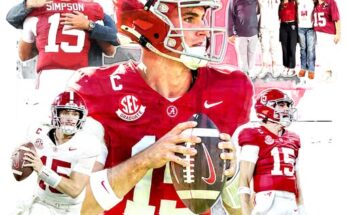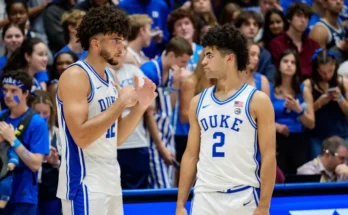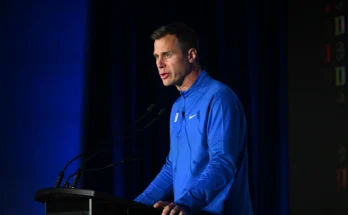In an NFL mock trade, the Dolphins make a significant move for top defensive line talent.
In a hypothetical shake-up that has NFL fans and analysts buzzing, the Miami Dolphins execute a bold move in this latest mock draft scenario—trading up to land one of the most dominant defensive line prospects in the 2025 NFL Draft. This aggressive play by general manager Chris Grier signals Miami’s win-now mentality and a desire to fortify a front that saw its share of attrition this past season.
With key departures and injuries leaving holes in the trenches, the Dolphins use their draft capital—and a touch of long-term planning—to orchestrate a blockbuster trade that nets them a top-tier defensive lineman many believe could become a franchise cornerstone. In this article, we break down the motivations behind the trade, the impact of the move, and how the player fits into Miami’s broader scheme as the team eyes another playoff run in the increasingly competitive AFC.
The Trade: Details of the Mock Move
The Deal
Dolphins receive:
- No. 6 overall pick in the 2025 NFL Draft
Cardinals receive:
- No. 18 overall pick (1st round)
- 2025 second-round pick
- 2026 first-round pick
- EDGE Emmanuel Ogbah
At first glance, the price is steep. But when the Dolphins evaluated their aging and injury-prone defensive front, especially after losing Christian Wilkins in free agency, it became clear that adding a game-wrecking lineman wasn’t a luxury—it was a necessity.
The Arizona Cardinals, on the other hand, use this mock scenario to build depth and stockpile future draft capital as they continue their long-term rebuild around quarterback Kyler Murray. For them, this trade represents an opportunity to offload the pressure of the No. 6 pick and gain flexibility.
Miami’s Defensive Line Dilemma
The Dolphins’ defensive front experienced significant regression in 2024. After a promising start, season-ending injuries to Jaelan Phillips and Bradley Chubb left the unit exposed, and the interior line struggled to generate consistent pressure. The team finished the season ranked 21st in total defense and 25th in sacks per game—a far cry from the top-10 defense it fielded just a year prior.
While Zach Sieler provided consistent play, the departure of Wilkins left a noticeable void in the middle. Adding pressure to the edge without reinforcements in the middle allowed opponents to scheme more effectively, exposing Miami in the run game and forcing extra blitzing from the linebacker corps.
The Dolphins’ coaching staff, including defensive coordinator Anthony Weaver, stressed the need for a disruptive force who could align in multiple fronts and collapse the pocket from the interior—someone who would require double teams and open up lanes for Miami’s blitz-happy scheme.
The Prize: Who the Dolphins Land
With the No. 6 pick, the Dolphins take Jeremiah “Tank” Jefferson, a 6’5”, 315-pound defensive lineman out of Georgia—a consensus top-5 talent and arguably the most dominant interior defender in this year’s draft class. A two-time All-American and the anchor of one of college football’s stingiest defenses, Jefferson is known for his rare blend of size, explosiveness, and violent hands.
In his final collegiate season, Jefferson posted 11.5 sacks, 19 tackles for loss, and 4 forced fumbles. More than just a stat producer, he commanded double teams every game and still lived in the backfield. NFL scouts have compared him to Chris Jones and Quinnen Williams, praising his motor, gap discipline, and uncanny ability to crash the pocket.
For Miami, Jefferson represents not just an elite talent but a scheme-versatile lineman who can shift between 3-tech, 5-tech, and even nose tackle depending on the look. His presence allows Weaver to get more creative with alignments and return to the kind of multiple-front, pressure-heavy scheme that helped Miami dominate during its 2023 playoff run.
Inside the War Room: Why the Dolphins Pulled the Trigger
Sources close to the team say the Dolphins had Jefferson circled early in the draft process. While he was projected to go within the top five, Miami’s scouting department noted the possibility that quarterbacks and wide receivers might push some top defensive players slightly down the board. When it became clear that Jefferson might still be available at No. 6, Grier made the call.
The team’s interest wasn’t just about on-field talent. Jefferson blew away team interviews at the NFL Combine with his leadership, humility, and work ethic. He’s considered a cultural fit for a Miami team that prides itself on toughness, accountability, and smart football IQ. “He’s a grown man already,” said one AFC scout. “Plug him in on day one, and he’ll change the attitude of your whole front.”
The Cost of Going Big
The trade, of course, comes with risk. Miami parts with three premium assets—two first-round picks and a second—along with veteran pass rusher Emmanuel Ogbah, who still offers value in a rotation. It’s a major investment for a team that just made the postseason but failed to advance past the Wild Card round.
Critics of the move argue that the Dolphins could have stayed at No. 18 and addressed defensive line needs with a player like Leonard Payne (Texas A&M) or T.J. Reed (Michigan), both of whom are expected to go in the late first round. But Miami clearly believes Jefferson is in another class altogether—an immediate game-changer.
Some also worry about the long-term implications. The Dolphins have extended Tua Tagovailoa, Tyreek Hill is nearing the end of his peak, and offensive line upgrades are still needed. Trading away future picks could limit the team’s flexibility in addressing those concerns.
How Jefferson Fits Into Miami’s Defense
Pairing Jefferson with Zach Sieler gives the Dolphins one of the most powerful interior tandems in the AFC. His ability to eat blocks will free up linebackers like David Long Jr. and Jerome Baker to flow downhill more effectively, while also taking pressure off Phillips and Chubb on the edge.
In Weaver’s simulated pressure schemes, Jefferson’s quick get-off becomes even more dangerous. Whether lined up over the guard or shaded over center, he’ll demand constant attention, forcing offenses to adjust protections and potentially creating mismatches elsewhere.
With Jefferson inside, look for the Dolphins to return to more base 4-2-5 sets, with a renewed ability to collapse the pocket and disguise coverages behind the rush. The emphasis on interior pressure also helps mitigate Miami’s thin depth at corner, giving the secondary less time to cover.
League Reaction: Praise and Caution
The mock trade scenario, which first appeared on CBS Sports’ Daniel Jeremiah’s latest big board analysis, has drawn widespread attention. Most analysts lauded Miami’s aggressiveness and willingness to address a premium position with premium capital.
“This is the kind of move contenders make,” said former NFL GM Mike Tannenbaum on ESPN. “When you believe in your quarterback, your head coach, and your locker room, you go get guys like Jefferson who can tilt the field.”
Others urged caution, noting that defensive linemen—especially those transitioning from the SEC—sometimes take time to adjust to NFL blocking schemes. “It’s not just plug and play,” said NFL Network’s Bucky Brooks. “He’ll be good, no question. But for that price, he has to be elite—fast.”
The Bigger Picture: AFC Arms Race
The move comes amid a larger arms race in the AFC. With the Chiefs and Bengals retooling, the Texans and Ravens surging, and the Jets getting Aaron Rodgers back healthy, the conference remains stacked. The Dolphins understand they need every edge to compete.
This trade—and the selection of a dominant interior defender—sends a message: Miami is done waiting. With a maturing quarterback, an experienced coaching staff, and a loaded offense, the window to win is open. And they’re willing to pay the price to chase it.
Smart Gamble or Costly Overreach?
Every draft day decision comes with uncertainty, but in this mock scenario, the Dolphins are clear in their intent: get tougher in the trenches, control the line of scrimmage, and dictate the tone on defense.
Jeremiah Jefferson may not play quarterback or catch touchdowns, but his impact could be just as vital. If he lives up to expectations, this trade could be remembered as the moment Miami took the leap from good to great. If not, it may haunt them for years.
But one thing’s for certain—this version of the Dolphins is done playing it safe.



